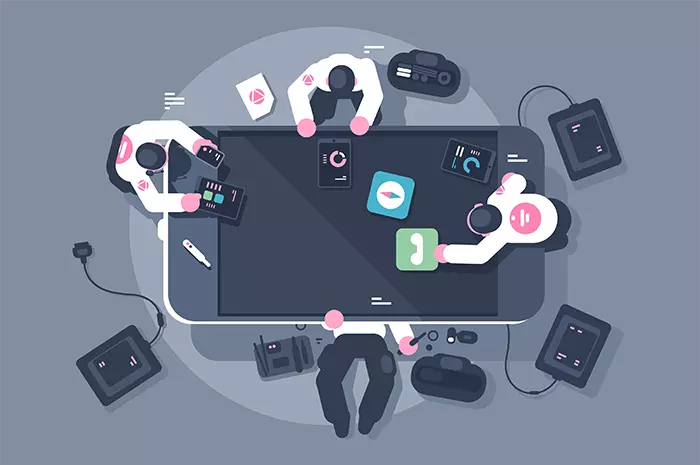Ever heard of "live chilling"?
According to the Wall Street Journal, teens are using video conferencing apps like House Party at an increasing rate – to the point where they now officially spend more time hanging out with their friends online than they do in person.
If you think that Generation Z is the only demographic being affected by the evolution of audio/video features, you're wrong.
Audio & video sharing enables communities from different backgrounds to communicate in an effective and enjoyable way. The result has been a boom in the communications and collaboration market, which Global Market Insights projects to reach $96 billion by 2023.
To support this, let's take a look at a couple of case studies.
Case Study #1: WhatsApp
Facebook released a WhatsApp update that targets video sharing. Industry experts predicted it would consume some of Snapchat's share in the lucrative mobile app messaging market.
Learn more about Audio and Video Calling Solution .
Once they download the update, users can share photos, videos and GIFs through a status feature. Just like Snapchat and Instagram Stories, users can overlay their status updates with drawings, emojis, and/or captions.
Yet another thing that the new update shares with Snapchat and Instagram Stories is that WhatsApp status updates must be shared within 24 hours, after which they disappear. The new update is protected by WhatsApp's famous end-to-end encryption.
This fundamental change to the WhatsApp user experience shows how much value Facebook sees in video sharing technology. Since its launch, WhatsApp has been focused almost entirely on text-based chatting. Now that users are encouraged to engage with new and diverse forms of content, the app's already enormous success has expanded exponentially.
Snapchat, a social media app dedicated to video chatting, has been the hardest hit by Facebook's strategic move.
The takeaway here is that audio/video sharing is both a competitive advantage and a necessary feature for modern social apps. Those who incorporate it will maintain relevance in consumers' eyes – but only the apps that truly capture their potential will see extraordinary ROI.
Do you have any social networking case studies to share? Leave us a message to let us know!
Case Study #2: Google Hangouts
Google Hangouts is Google's own audio/video conferencing app. It caters to business collaboration through group chatting. Specifically, the update simplifies the creation of group chats through Gmail and the Chrome extension.
It proves that video/audio sharing isn't just for your everyday consumer – it's a valuable enterprise mobility tool. Google Hangouts is an excellent basic video sharing service that's great to have at hand.
However, the true advantage in video/audio chatting lies in custom web apps tailored to your organization's needs. From desktop sharing to advanced text chatting tools, custom web app development enables you to find the solutions that maximize operational efficiency of how your employees collaborate.
To discuss what the ideal solution looks like for your company, get in touch and chat with one of BluEnt's professional developers today.
It's important to acknowledge the difference between audio/video use in the workplace and in casual conversation. It can be tricky to learn the etiquette of chatting in a corporate environment. Thus, for those in business settings, here are a few tips to keep in mind:
When joining a video conference, always arrive at least 5 minutes early to allow for any technical difficulties.
As a general rule, choose video chatting over audio chatting unless there is a specific reason to do otherwise. (Virtual) face-to-face communication allows for a more personal connection and thus a more productive meeting.
A specific case where turning off your video feed is expected is when a video conference is centered around a presentation rather than a general discussion. This helps keep the attention on the person screen sharing or making important points without interruption.
Even though it's natural to stare at a person's face in the middle of your screen while video sharing, try to look into the camera to simulate eye contact when you're speaking.
If someone else is speaking during an audio conference call, it may be helpful to mute your own audio to ensure that you don't disturb their speech with background noise.
That said, do your best to find a spot with good lighting (for video sharing) and a lack of noise (for audio sharing). Although a simple step, it shows consideration for the other people on the call and greatly improves their overall experience.
Ready to incorporate audio/video features into your business and watch your ROI increase? BluEnt has years of experience creating mobile and web app solutions for our clients, particularly in the field of audio & video chatting tools.
Give us a call get your personalized audio/video tool!
Recommended Reads:
Maximum Value. Achieved.



 How Much Does App Development Cost? A Budget Estimation Guide
How Much Does App Development Cost? A Budget Estimation Guide  Using Angular to Develop Mobile Apps Can Be a Game Changer for Your Business
Using Angular to Develop Mobile Apps Can Be a Game Changer for Your Business  Pros and Cons of the WooCommerce Plugin for Online Merchants
Pros and Cons of the WooCommerce Plugin for Online Merchants  Mean Stack vs LAMP Stack: Which One is Better for Your Business?
Mean Stack vs LAMP Stack: Which One is Better for Your Business? 